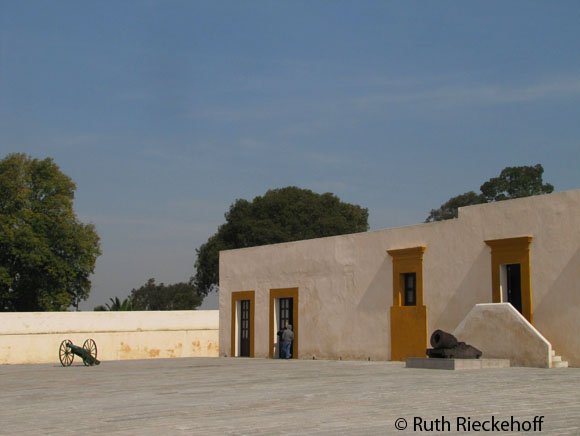Take a look at the role the Loreto Fort had in the Battle of Puebla (the battle associated with the famous 5 de mayo).
I already wrote a detailed post about the Guadalupe Fort and its role in the Battle of Puebla (better known by its date, 5 de mayo). However, I cannot forget about the other fort at the “5th of May Civic Center” (Centro Civico 5 de Mayo).
In an effort to defend tiny, simple things, you can hear people saying, “The best perfume comes in small bottles.” It is obvious they want to emphasize quality over quantity.
Well, think about the Loreto Fort in the same terms of good perfume. The place, a small structure surrounded by thick but low defensive walls, may look deceptive at first. All those feelings go away when you start to realize the role this place has had in 350 years of history. It probably has seen more wars, battles, coup d’etats, and schemes than more grandiose structures.
The fort started to exist as a shrine, built in the 17th century because a native assured he was saved from lighting by the Virgin of Loreto. Since 1789, the authorities started to use the shrine as a strategic place to defend the city of Puebla (and as a prison).
When the independence movement began, the building was fortified. Religious objects were removed and survival elements such as kitchens were added. Therefore, the first battles seen by the fort took place between authorities representing the government of Spain and rebels.
After independence, when the Mexican government was fragile, a man named Antonio Lopez de Santa Anna stirred up a rebellion against the recognized president. Santa Anna used the Loreto Fort as its operations center. He was able to take the presidency in 1833.
In 1845, Texas was annexed by the United States (Santa Anna lost the territory in 1836). A territorial dispute ended with the United States declaring war on Mexico. Santa Anna came back to stop the United States Army (he was president 10 or 11 times).
After many battles, the forces of the United States were able to take the Loreto Fort (and other buildings) before marching to Mexico City. Mexico ended up losing half of its territory.
Fame came to the Loreto Fort on May 5, 1862, when the Battle of Puebla was fought in nearby Guadalupe Fort. The French retired before making it to the Loreto Fort (that is why it is so well preserved). Learn more about what happened that day here.
If you want to learn specific details about the Battle of Puebla and Mexican history, go to the Loreto Fort. The posters and signs inside the structure provide very good information. There is even a timeline resuming the history of Mexico (very interesting by the way).
My take on the forts? The Guadalupe Fort contains a lot of artifacts (documents, coins, swords, etc.) dating from the Battle of Puebla time. The Loreto Fort contains fewer artifacts but a more detailed explanation of the actual events. I prefer the Loreto Fort and would recommend it if you only want to see one fort. If you still want to enter both forts, go to the Loreto one first.
This time I preferred the simplicity of the Loreto Fort. I took time to observe its internal patio and walk around its walls. It is hard to believe this place is still standing. But maybe it does because it has so many stories to tell.
Have you visited the Loreto Fort?









Leave a Reply